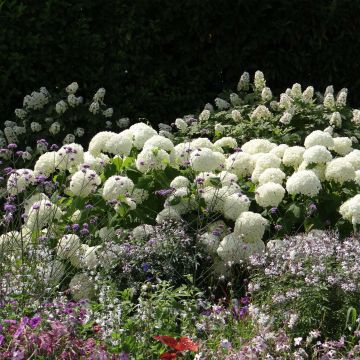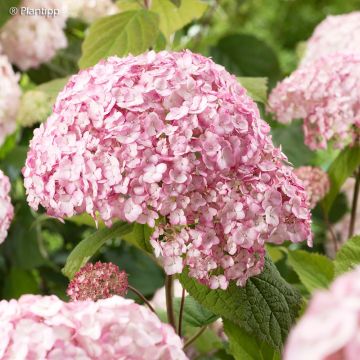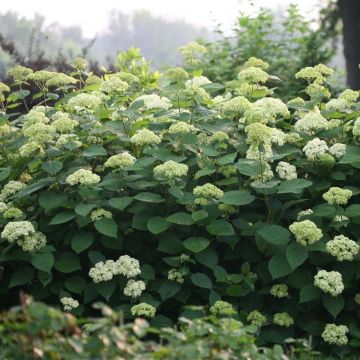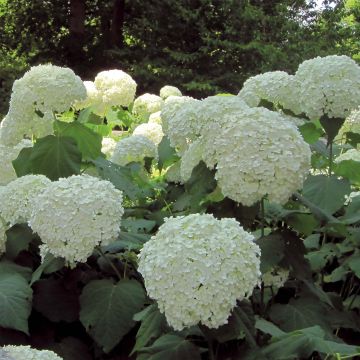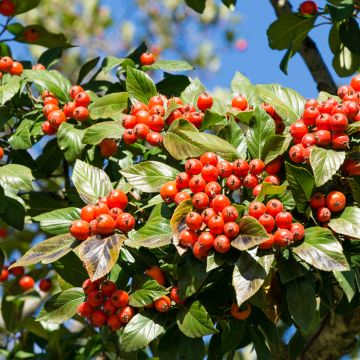

Hortensia - Hydrangea arborescens Candybelle Marshmallow


Hortensia - Hydrangea arborescens Candybelle Marshmallow


Hortensia - Hydrangea arborescens Candybelle Marshmallow


Hortensia - Hydrangea arborescens Candybelle Marshmallow


Hortensia - Hydrangea arborescens Candybelle Marshmallow
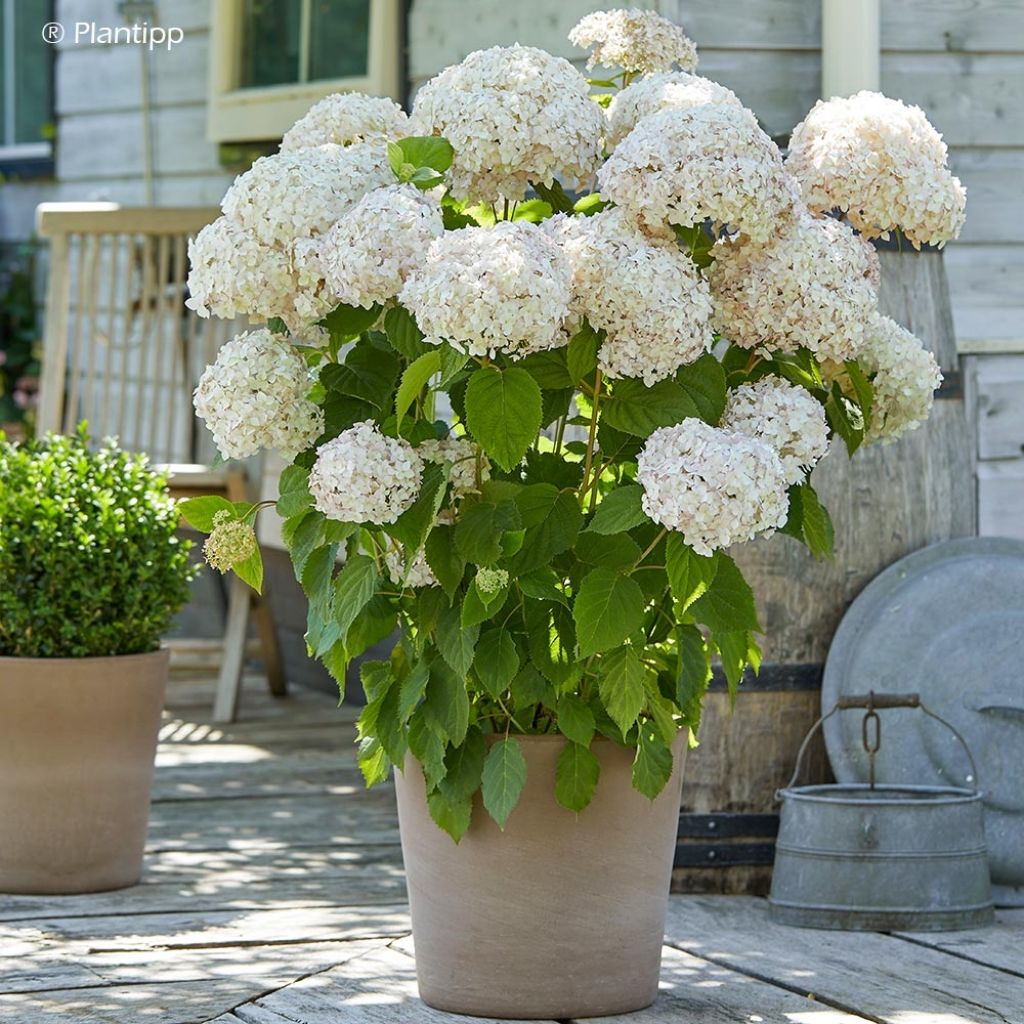

Hortensia - Hydrangea arborescens Candybelle Marshmallow
Hydrangea arborescens Candybelle Marshmallow
Hydrangea arborescens Candybelle® Marshmallow (‘GRHYAR1406’)
Smooth Hydrangea, Wild Hydrangea, Sevenbark
Beautiful
Marc E., 14/06/2023
This item cannot be shipped to the selected country
Delivery charge from €5.90
More information
Schedule delivery date,
and select date in basket
This plant carries a 24 months recovery warranty
More information
We guarantee the quality of our plants for a full growing cycle, and will replace at our expense any plant that fails to recover under normal climatic and planting conditions.
From €5.90 for pickup delivery and €6.90 for home delivery
Express home delivery from €8.90.
Does this plant fit my garden?
Set up your Plantfit profile →
Description
Hydrangea arborescens Candybelle Marshmallow (‘GRHYAR1406’) is a new variety of small-sized Virginia hydrangea, which is floriferous, hardy, and easy to grow. It's a lovely rounded bush that produces large fluffy flowers painted in pale salmon-pink throughout the summer. Its short and sturdy stems effortlessly support the weight of the flowers, even when soaked with rain. This wonderful hydrangea is as resplendent in the garden as it is in a beautiful pottery on the terrace.
Hydrangea arborescens, also called Virginia Hydrangea, belongs to the large Hydrangeaceae family. This botanical species native to the Southeast USA is less demanding in terms of shade and soil than its Asian counterparts, and therefore very easy to grow in any moist and loose soil.
Candybelle Marshmallow is a very hardy plant (up to -25°C (-13°F)) that faithfully reflowers even after cold winters. It flowers on the current year's shoots. It can be planted in cold regions as it renews its floral buds all summer and does not fear spring frosts. It develops sturdy and ramified stems, forming a bush of about 80 to 90 cm (32 to 35in) in all directions, making it ideal for cultivation in containers or pots. The flowering begins in early July and renews until September. It takes the form of large globular inflorescences called corymbs, measuring up to 20cm (8in) in diameter. Each one is made up of a multitude of small flowers called florets. Each floret has 3 to 4 light salmon-pink sepals. The bright green foliage is composed of beautiful single leaves 10 to 20cm (4 to 8in) long, with bronze reflections. The leaves are deciduous and fall in autumn. Hydrangeas can live for over 50 years.
This variety is small, floriferous, robust, and easy to grow in any good garden soil. If your decor is rather contemporary, or if you have a small city garden, this moderately sized bush will bring a romantic and natural touch. Candybelle Marshmallow livens up all semi-shade scenes. Plant it as a standalone, in groups of 3, in a small hedge, or in a pot on a terrace. Consider planting a small border of box or Lonicera nitida 'Elegant' to form a setting for its large flowers. It can also be surrounded by hellebores, hardy fuchsias, daffodils and pansies which prolong the flowering and complete the range of colours. Finally, cut its flowers to create beautiful bouquets!
Report an error about the product description
Hydrangea arborescens Candybelle Marshmallow in pictures




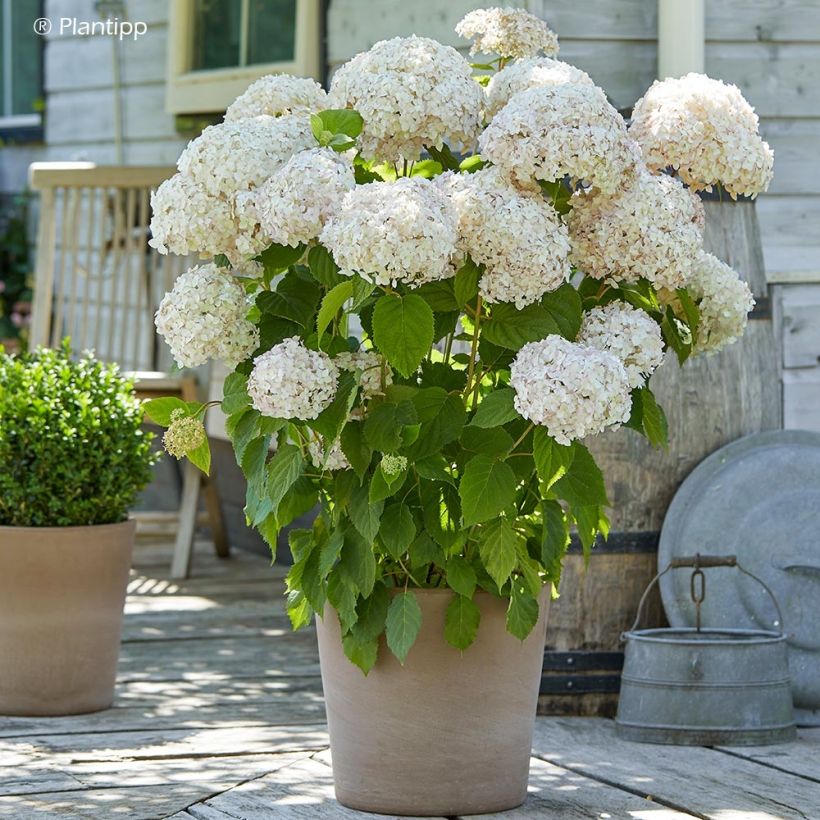

Plant habit
Flowering
Foliage
Botanical data
Hydrangea
arborescens
Candybelle® Marshmallow (‘GRHYAR1406’)
Hydrangeaceae
Smooth Hydrangea, Wild Hydrangea, Sevenbark
Cultivar or hybrid
Other Hydrangea arborescens
Planting and care
Candybelle Marshmallow requires a location in the sun or light shade, and deep, loose, moist, slightly acidic, compost-enriched ordinary garden soil, without excess lime. When planting, set it in deeply worked soil. A good base fertiliser (horn or dehydrated blood) will promote the recovery of your young plant and nourish it without risk of burning. The plant is perpetual, do not hesitate to cut the faded flowers regularly in summer. At the end of summer, leave the dry umbels on the plant as they will protect the terminal shoots in winter. You can remove the dried flowers at the end of February or at the first sign of warm weather.
Planting period
Intended location
Care
-
, onOrder confirmed
Reply from on Promesse de fleurs
Summer-flowering shrubs
Haven't found what you were looking for?
Hardiness is the lowest winter temperature a plant can endure without suffering serious damage or even dying. However, hardiness is affected by location (a sheltered area, such as a patio), protection (winter cover) and soil type (hardiness is improved by well-drained soil).

Photo Sharing Terms & Conditions
In order to encourage gardeners to interact and share their experiences, Promesse de fleurs offers various media enabling content to be uploaded onto its Site - in particular via the ‘Photo sharing’ module.
The User agrees to refrain from:
- Posting any content that is illegal, prejudicial, insulting, racist, inciteful to hatred, revisionist, contrary to public decency, that infringes on privacy or on the privacy rights of third parties, in particular the publicity rights of persons and goods, intellectual property rights, or the right to privacy.
- Submitting content on behalf of a third party;
- Impersonate the identity of a third party and/or publish any personal information about a third party;
In general, the User undertakes to refrain from any unethical behaviour.
All Content (in particular text, comments, files, images, photos, videos, creative works, etc.), which may be subject to property or intellectual property rights, image or other private rights, shall remain the property of the User, subject to the limited rights granted by the terms of the licence granted by Promesse de fleurs as stated below. Users are at liberty to publish or not to publish such Content on the Site, notably via the ‘Photo Sharing’ facility, and accept that this Content shall be made public and freely accessible, notably on the Internet.
Users further acknowledge, undertake to have ,and guarantee that they hold all necessary rights and permissions to publish such material on the Site, in particular with regard to the legislation in force pertaining to any privacy, property, intellectual property, image, or contractual rights, or rights of any other nature. By publishing such Content on the Site, Users acknowledge accepting full liability as publishers of the Content within the meaning of the law, and grant Promesse de fleurs, free of charge, an inclusive, worldwide licence for the said Content for the entire duration of its publication, including all reproduction, representation, up/downloading, displaying, performing, transmission, and storage rights.
Users also grant permission for their name to be linked to the Content and accept that this link may not always be made available.
By engaging in posting material, Users consent to their Content becoming automatically accessible on the Internet, in particular on other sites and/or blogs and/or web pages of the Promesse de fleurs site, including in particular social pages and the Promesse de fleurs catalogue.
Users may secure the removal of entrusted content free of charge by issuing a simple request via our contact form.
The flowering period indicated on our website applies to countries and regions located in USDA zone 8 (France, the United Kingdom, Ireland, the Netherlands, etc.)
It will vary according to where you live:
- In zones 9 to 10 (Italy, Spain, Greece, etc.), flowering will occur about 2 to 4 weeks earlier.
- In zones 6 to 7 (Germany, Poland, Slovenia, and lower mountainous regions), flowering will be delayed by 2 to 3 weeks.
- In zone 5 (Central Europe, Scandinavia), blooming will be delayed by 3 to 5 weeks.
In temperate climates, pruning of spring-flowering shrubs (forsythia, spireas, etc.) should be done just after flowering.
Pruning of summer-flowering shrubs (Indian Lilac, Perovskia, etc.) can be done in winter or spring.
In cold regions as well as with frost-sensitive plants, avoid pruning too early when severe frosts may still occur.
The planting period indicated on our website applies to countries and regions located in USDA zone 8 (France, United Kingdom, Ireland, Netherlands).
It will vary according to where you live:
- In Mediterranean zones (Marseille, Madrid, Milan, etc.), autumn and winter are the best planting periods.
- In continental zones (Strasbourg, Munich, Vienna, etc.), delay planting by 2 to 3 weeks in spring and bring it forward by 2 to 4 weeks in autumn.
- In mountainous regions (the Alps, Pyrenees, Carpathians, etc.), it is best to plant in late spring (May-June) or late summer (August-September).
The harvesting period indicated on our website applies to countries and regions in USDA zone 8 (France, England, Ireland, the Netherlands).
In colder areas (Scandinavia, Poland, Austria...) fruit and vegetable harvests are likely to be delayed by 3-4 weeks.
In warmer areas (Italy, Spain, Greece, etc.), harvesting will probably take place earlier, depending on weather conditions.
The sowing periods indicated on our website apply to countries and regions within USDA Zone 8 (France, UK, Ireland, Netherlands).
In colder areas (Scandinavia, Poland, Austria...), delay any outdoor sowing by 3-4 weeks, or sow under glass.
In warmer climes (Italy, Spain, Greece, etc.), bring outdoor sowing forward by a few weeks.

































